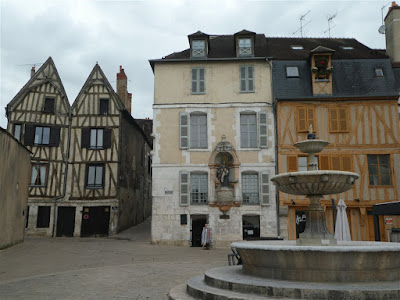After Beaune we turned west to head for our favorite cathedral, St. Etienne's in Bourge. We got as far at Nerondes, a sleepy village some miles short of our goal. The
aire de camping-cars in Nerondes was the church parking lot, with camper amenities across the street near the public playing fields. We went for a walk in search of an appealing restaurant, but, finding none (one too pricey, one a questionable kabob/pizza joint) we returned to an improvised meal in the camper, reflecting on how vastly different French and Italian towns are. In France, one church, 1-2 eating places. In Italy, half a dozen churches, some on the same block, and a dozen or more trattoria/pizza joints. Anyhow, on the walk we encountered the town's 19th century
lavoir (
bassin public), the communal washing place, versions of which were widespread in Europe until the advent of washing machines, but not all of which have survived. We'd seen several doing the
Camino in Spain, but not before in France. FWIW.


















































